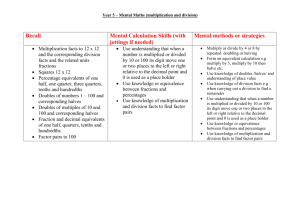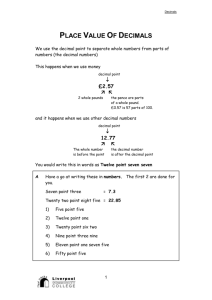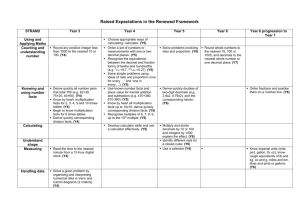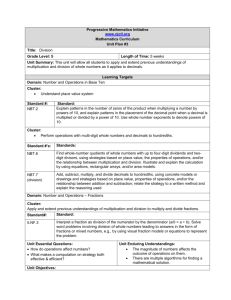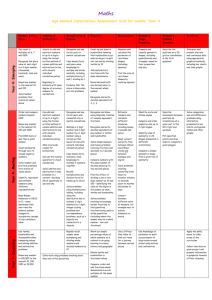calculations policy year 5(1)
advertisement
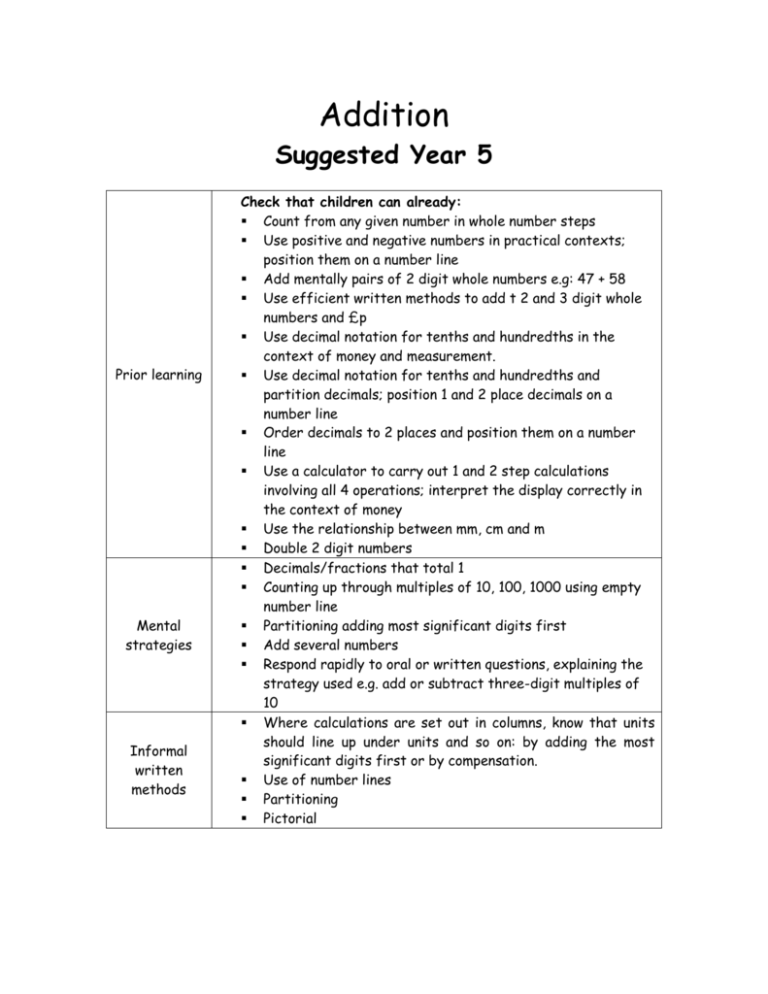
Addition Suggested Year 5 Prior learning Mental strategies Informal written methods Check that children can already: Count from any given number in whole number steps Use positive and negative numbers in practical contexts; position them on a number line Add mentally pairs of 2 digit whole numbers e.g: 47 + 58 Use efficient written methods to add t 2 and 3 digit whole numbers and £p Use decimal notation for tenths and hundredths in the context of money and measurement. Use decimal notation for tenths and hundredths and partition decimals; position 1 and 2 place decimals on a number line Order decimals to 2 places and position them on a number line Use a calculator to carry out 1 and 2 step calculations involving all 4 operations; interpret the display correctly in the context of money Use the relationship between mm, cm and m Double 2 digit numbers Decimals/fractions that total 1 Counting up through multiples of 10, 100, 1000 using empty number line Partitioning adding most significant digits first Add several numbers Respond rapidly to oral or written questions, explaining the strategy used e.g. add or subtract three-digit multiples of 10 Where calculations are set out in columns, know that units should line up under units and so on: by adding the most significant digits first or by compensation. Use of number lines Partitioning Pictorial Formal written methods expanded & compact plus examples Model and images examples Written methods HTU+HTU, ThHTU+HTU with carrying Extend to decimals (up to 3 digits, not just money) Continue to develop an efficient standard method that can be applied generally – using carrying Extend to decimals 587 +475 1062 ¹¹ 500 + 400 = 900 80 + 70 = 150 7 + 5 = 12 900 + 150 + 12 = 1062 Carrying Partition adding most significant first Which three numbers could have a total of 450? How many altogether are 121 and 345? Use a calculator to find all the different totals you can make by using three of these five numbers: 8, 4008, 562, 3103, 95. Key questions Tim has saved £86 for an electronic player costing £119. Which number sentence could Tim use to find how much more he needs to save? A 119 + 86 = ? B ? – 86 = 119 Opportunities for using and applying Problem Solving – word problems Puzzles Practical problems Creative links with topic planned work Investigations such as “Lunar Maths” problem, solution, calculate, calculation, equation, operation, answer, method, explain, predict, reason, reasoning, pattern, relationship, rule, sequence place value, partition, thousands, digit, four-digit number, decimal point, decimal place, tenths, hundredths 1000 more Vocabulary positive, negative, above/below zero, compare, order, greater than ( ), less than ( ), equal to ( ), round, estimate, approximately add, sum, total, difference, plus, calculator, display, key, enter, clear, constant pound ( ), penny/pence (p), units of measurement and abbreviations, degrees Celsius ( C) Subtraction Suggested Year 5 Check that children can already: Prior learning Count from any given number in whole number steps Use positive and negative numbers in practical contexts; position them on a number line Subtract mentally pairs of 2 digit whole numbers eg. 91-35 Use efficient written methods to subtract 2 and 3 digit whole numbers and £p Use decimal notation for tenths and hundredths in the context of money and measurement. Use decimal notation for tenths and hundredths and partition decimals; position 1 and 2 place decimals on a number line Order decimals to 2 places and position them on a number line Use a calculator to carry out 1 and 2 step calculations involving all 4 operations; interpret the display correctly in the context of money Use the relationship between mm, cm and m Mental strategies Informal written methods Blank number lines 100 square Jottings Use informal pencil and paper jottings to answer: ? + 756 = 924; ? + ? = 1; ? − 256 = 424; ? − ? = 1.2 Pictorial jottings Place value of numbers especially in columns Formal written methods expanded & compact plus examples Find differences by counting up through next multiple of 10, 100, 1000; Partition into H, T and U, adding the most significant digits first; Identify near doubles; Add several numbers, making multiples of 10s, 100s etc. Decomposition using partitioning to support which then leads onto a more compact method; Extend to decimals with up to 3 digits and the same number of decimals places. Use a written method to answer: o 14 136 + 3258 + 487 =?; o 141.36 32.58 Number lines (for larger numbers than these examples e.g HTU – TU, HTU – HTU) When counting on or back jump to the nearest multiple of 10 first as in above examples. Decomposition: 754 = 700 + 50 + 4 - 286 200 + 80 + 6 ------------------------Model and images examples 700 + 40 + 14 - 200 + 80 + 6 Short method: 6 14 7 514 -286 468 600 + 140 + 14 - 200 + 80 + 6 ---------------------400 + 60 + 8 = 468 Respond rapidly to oral or written questions, explaining the strategy used. Subtract 50 from 225 What is the difference between 155 and 390? Decrease 650 by 25. 570 add a number is 590. Use known facts to answer: ? + 62 = 189; ? − 62 = 189; 7.6 − 5.8 = ? Use a calculator to: Find all the differences you can make by using two of the numbers. Key questions Opportunities for using and applying Which of these subtractions can you do without writing anything down? Why is it possible to solve this one mentally? What clues did you look for? What is the answer to the one that can be solved mentally? How did you find the difference? Talk me through your method. [If the child explains a method of counting backwards, ask:] Is it possible to count up as well? Why will this give the same result? Which is easier? If 2003 is the answer to a similar question, what could the question be? Roughly, what will the answer to this calculation be? How do you know that this calculation is probably right? Could you check it a different way? Word problems Practical problems Puzzles Creative links with topic planned work problem, solution, calculate, calculation, equation, operation, answer, method, explain, reasoning, reason, predict, relationship, rule, formula, pattern, sequence, term, consecutive, discount Vocabulary place value, digit, numeral, partition, decimal point, decimal place, thousands, ten thousands, hundred thousands, millions, tenths, hundredths, positive, negative, above/below zero, compare, order, ascending, descending, greater than ( ), less than ( ), round, estimate, approximately calculator, display, key, enter, clear, constant Multiplication Suggested Year 5 Prior learning Mental strategies Informal written methods Check that children can already: Count from any given number in whole number steps Use positive and negative numbers in practical contexts; position them on a number line Recall multiplication facts to 10 x 10 Multiply 1000 by 10 and then 100 (whole number answers) Use written methods to multiply TU x U Use decimal notation for tenths and hundredths in the context of money and measurement. Use decimal notation for tenths and hundredths and partition decimals; position 1 and 2 place decimals on a number line Order decimals to 2 places and position them on a number line Use a calculator to carry out 1 and 2 step calculations involving all 4 operations; interpret the display correctly in the context of money Use the relationship between mm, cm and m Use diagrams to identify equivalent fractions eg 6/8 and ¾ or 7/100 and 7/10; interpret mixed numbers and position them on a number line eg 3 1/2 Know the equivalence between decimal and fraction forms of one half, one quarter, tenths and hundredths Double 2 digit numbers Use written methods to record, support and explain multiplication of 2 digit numbers by a 1 digit number including division with remainders eg 15 x9 Use the vocabulary of ratio and proportion Calculate all multiplication tables. Using mental and pen and paper methods to answer missing number questions Use division as the inverse of multiplication Mentally, supported by jottings. Approximation. Formal written methods expanded & compact plus examples Grid method HTUxU, TUxTU, Partitioning Short multiplication HTUxU Long multiplication TUxTU Model and images examples Grid Method Key questions Opportunities for using and applying Vocabulary If someone had forgotten the 8 times-table, what tips would you give them to help them to work it out? What links between multiplication tables are useful? How many nines are there in 63? Write in the missing numbers. 5 70 600 4 4 200 What is 50 times 90? This calculator display shows 0.1. Tell me what will happen when I multiply by 100. What will the display show? What number is ten times as big as 0.01? How do you know that it is ten times 0.01? How would you explain to someone how to multiply a decimal by 10? What is a quick way to multiply by 1000? One sticker book costs £1.35. How much would five sticker books cost? How did you work it out? Could you do it differently? Estimate; approximate; approximately; brackets, inverse, product, times, multiply, multiplied by, once, twice, three times, four times, five times, …. ten times, times as (big, long, wide and so on) repeated addition array row, column times table DIVISION Suggested Year 5 Prior learning Mental strategies See Year 4 Check that children can already: Count from any given number in whole number steps Use positive and negative numbers in practical contexts; position them on a number line Add or subtract mentally pairs of 2 digit whole numbers eg 47 + 58, 91-35 Use efficient written methods to add and subtract 2 and 3 digit whole numbers and £p Recall multiplication and division facts to 10 x 10 Multiply or divide numbers to 1000 by 10 and then 100 (whole number answers) Use written methods to multiply and divide TU x U, TU÷U Use decimal notation for tenths and hundredths in the context of money and measurement. Use decimal notation for tenths and hundredths and partition decimals; position 1 and 2 place decimals on a number line Order decimals to 2 places and position them on a number line Use a calculator to carry out 1 and 2 step calculations involving all 4 operations; interpret the display correctly in the context of money Use the relationship between mm, cm and m Use diagrams to identify equivalent fractions eg 6/8 and ¾ or 7/100 and 7/10; interpret mixed numbers and position them on a number line eg 3 1/2 Know the equivalence between decimal and fraction forms of one half, one quarter, tenths and hundredths Double and half 2 digit numbers Use written methods to record, support and explain multiplication and division of 2 digit numbers by a 1 digit number including division with remainders eg 15 x 9, 98 ÷6 Use the vocabulary of ratio and proportion Rapid recall of tables facts and related division facts Tables Facts and corresponding division facts and links to fractions Informal written methods Formal written methods expanded & compact plus examples Model and images examples Knowing ÷ 0 is not possible Is there a remainder after HTU÷U? Relate division to fractions – practical problems Knowing ÷ is not commutative Divided whole numbers by 10,100,1000 Division facts up to 10 x 10 Chunking method for HTU÷U Bus stop method Chunking method Bus stop method 540 ÷ 6 = 0 90 6 )5 54 0 6 x 50 = 300 6 x 40 = 240 So, 6 x 90 = 540 Therefore, 540 ÷ 6 = 90 Key questions Opportunities for using and applying __ How many 6s in 5? 0, carry the 5. How many 6s in 54? 9 How many 6s in 0? 0 Look at Y5 Resources/ Pitch and Expectations to give levelled word problems from past NCT papers to support learning, teaching and plenaries. Find fractions of amounts using division and multiplication. Find fractions using division e.g 1/100 of 5KG Solve problems using fractions Use % of numbers for quantities e.g 15% of £80.00 Solve problems using percentages Use a calculator to solve problems involving decimals Vocabulary problem, solution, calculator, calculate, calculation, equation, operation, symbol, inverse, answer, method, explain, predict, reason, reasoning, pattern, relationship, divide, product, quotient, remainder, multiple, common multiple, factor, divisor, divisible by decimal fraction, decimal place, decimal point, percentage, per cent (%) discount e.g: 20% of £5.00 =


